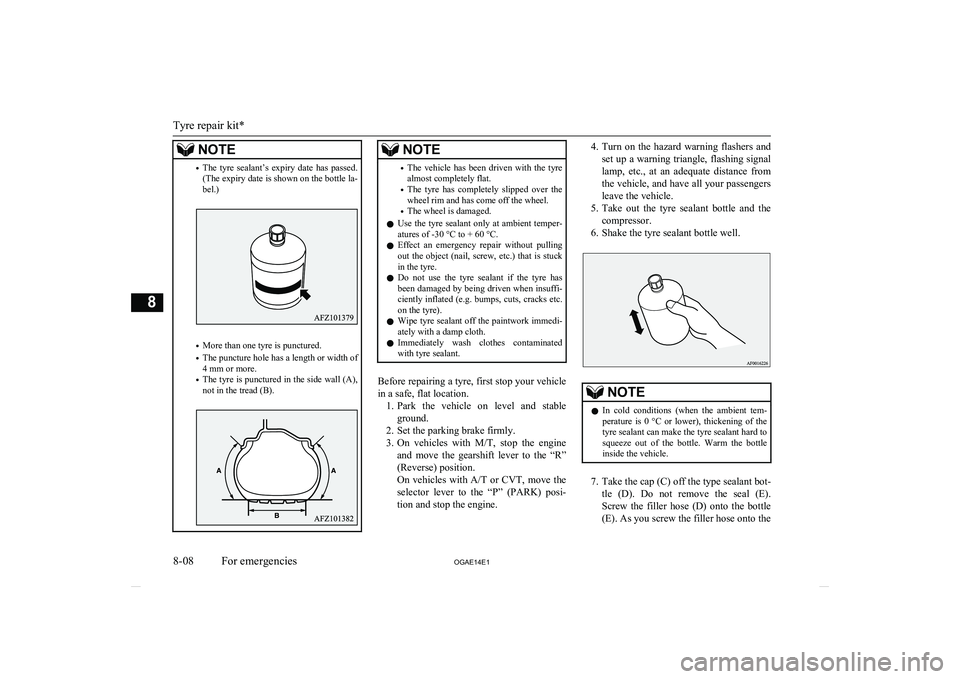Page 324 of 418

NOTE•The tyre sealant’s expiry date has passed.
(The expiry date is shown on the bottle la- bel.)
• More than one tyre is punctured.
• The puncture hole has a length or width of
4 mm or more.
• The tyre is punctured in the side wall (A),
not in the tread (B).
NOTE• The vehicle has been driven with the tyre
almost completely flat.
• The tyre has completely slipped over the
wheel rim and has come off the wheel.
• The wheel is damaged.
l Use the tyre sealant only at ambient temper-
atures of -30 °C to + 60 °C.
l Effect an emergency repair without pulling
out the object (nail, screw, etc.) that is stuck
in the tyre.
l Do not use the tyre sealant if the tyre has
been damaged by being driven when insuffi- ciently inflated (e.g. bumps, cuts, cracks etc.
on the tyre).
l Wipe tyre sealant off the paintwork immedi-
ately with a damp cloth.
l Immediately wash clothes contaminated
with tyre sealant.
Before repairing a tyre, first stop your vehicle
in a safe, flat location. 1. Park the vehicle on level and stable
ground.
2. Set the parking brake firmly.
3. On vehicles with M/T, stop the engine
and move the gearshift lever to the “R”
(Reverse) position.
On vehicles with A/T or CVT, move the
selector lever to the “P” (PARK) posi- tion and stop the engine.
4. Turn on the hazard warning flashers and
set up a warning triangle, flashing signal
lamp, etc., at an adequate distance from
the vehicle, and have all your passengers
leave the vehicle.
5. Take out the tyre sealant bottle and the
compressor.
6. Shake the tyre sealant bottle well.NOTEl In cold conditions (when the ambient tem-
perature is 0 °C or lower), thickening of the
tyre sealant can make the tyre sealant hard to squeeze out of the bottle. Warm the bottleinside the vehicle.
7. Take the cap (C) off the type sealant bot-
tle (D). Do not remove the seal (E). Screw the filler hose (D) onto the bottle
(E). As you screw the filler hose onto the
Tyre repair kit*
8-08 OGAE14E1For emergencies8
Page 356 of 418

NOTElThe washer fluid container serves the wind-
screen, rear window and headlamps (if soequipped).
During cold weather
To ensure proper operation of the washers at
low temperatures, use a fluid containing ananti-freezing agent.
Brake fluid/Clutch fluid*
E01000800631
The brake fluid and the clutch fluid share thereservoir tank.
To check the fluid level
The fluid level must be between the “MAX” and “MIN” marks on the reservoir.
The fluid level is monitored by a float. When
the fluid level falls below the “MIN” mark, the brake fluid warning lamp lights up.The fluid level falls slightly with wear of the brake pads, but this does not indicate any ab-
normality.
The fluid in the master cylinder should be checked when doing other work under thebonnet. The brake system should also be checked for leakage at the same time.
If the fluid level falls markedly in a short length of time, it indicates leaks from the
brake system.
If this occurs, we recommend you to have the
vehicle checked.
Fluid type
Use brake fluid conforming to DOT3 or DOT4 from a sealed container. The brake
fluid is hygroscopic. Too much moisture in the brake fluid will adversely affect the brake
system, reducing the performance.
CAUTIONl Take care in handling brake fluid as it is
harmful to the eyes, may irritate your skin
and also damage painted surfaces.CAUTIONl Use only the specified brake fluid.
Do not mix or add different brands of brake fluid to prevent chemical reactions.
Do not let any petroleum-based fluid touch, mix with, or get into the brake fluid.
This will damage the seals.
l Keep the reservoir tank cap closed to pre-
vent the brake fluid from deteriorating ex- cept maintenance.
l Clean the filler cap before removing and
close the cap securely after maintenance.Battery
E01001202229
The condition of the battery is very important
for quick starting and to keep the vehicle’s electrical system working properly. Regularinspection and care are especially importantin cold weather.
Type 1Type 2
Brake fluid/Clutch fluid*
10-08 OGAE14E1Maintenance10
Page 389 of 418
Vehicle dimensionsE011002040381Front track1,525 mm2Overall width1,770 mm3Front overhang870 mm4Wheel base2,670 mm5Rear overhang755 mm6Overall length4,295 mm7Ground clearance (unladen)Petrol-powered vehicles180 mm, 195 mm*1Diesel-powered vehicles180 mm*1
: Vehicles for Russia, Kazakhstan and Ukraine
Vehicle dimensions
11-05
OGAE14E1Specifications11